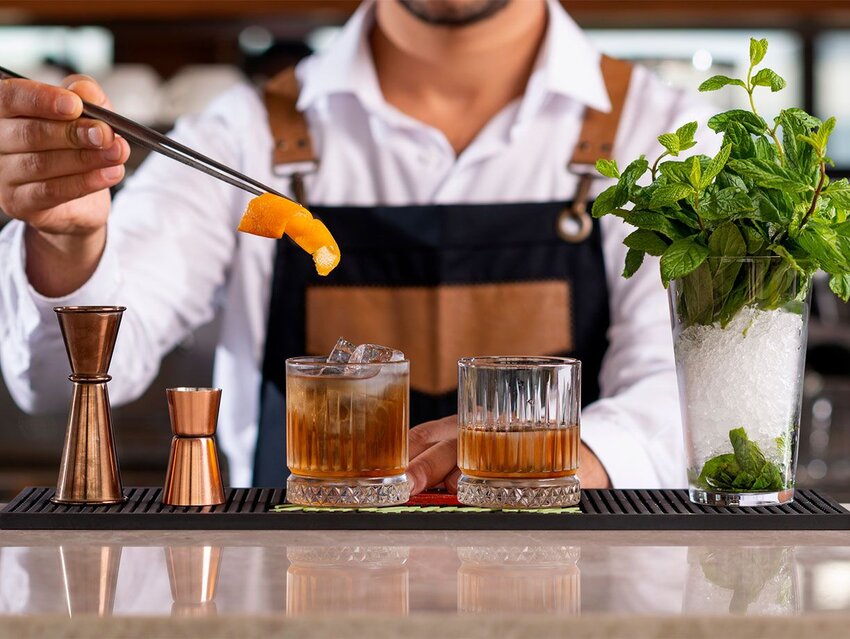Just as different cultures have their own traditions around drinking alcohol, they came to discover it in just as many ways: Wine was fermented in the Caucasus by 6000 BCE, and the Sumerians were brewing beer by 3000 BCE. The Chinese began drinking a fermented beverage of rice, honey, and fruit as early as 7000 BCE, and during the Chinese Sheng Dynasty (1200 - 1046 BCE), they had at least three fermented beverages called chang, jiu, and li. The Aztecs (150 BCE - 650 CE) used the same type of agave plants used to make tequila today to make an alcoholic beverage called pulque.
Since these ancient beginnings, the culture surrounding the consumption of alcohol has grown in sophistication in the form of craft beers, small-batch natural wines, and of course, many different varieties of mixed cocktails. The language surrounding the bar has deepened, as well. Read on to learn the industry lingo bartenders use when preparing your libations.
Cocktail
This term informs so many other words in bartending jargon. A cocktail is an alcoholic drink made up of a spirit, or several spirits, mixed with other ingredients, such as soda, fruit juice, bitters, or cream. These “strong, stimulating, cold American” drinks were first called “cocktails” around 1800. There are multiple possible origins, with the most durable being the French coquetier, meaning “egg-cup.” In New Orleans around 1795, an apothecary named Antoine Amédée Peychaud hosted Masonic social gatherings at his pharmacy where he served mixed brandy beverages in egg-cups. These brandy drinks were reportedly the first to be called cocktails. John Ayto’s Diner’s Dictionary derives the alcoholic word from the literal meaning of “horse with a docked tail,” or one cut short to make it stand up like a rooster’s comb. Because this dressing was given to ordinary horses (as opposed to thoroughbreds), the word came to mean “horse of mixed pedigree” by 1800, which some suggest was extended to drinks by way of “adulteration, mixture.”
The word “mocktail” has appeared in recent years, meaning a beverage made without alcohol. Instead of just plain soda or juice, it’s usually still made of several ingredients and crafted like a cocktail. Bartenders have been adding these faux cocktails to their menus to appeal to patrons who want to sip a specialty concoction, but without the alcohol.
Aperitif
An aperitif is an alcoholic drink consumed before a meal, typically to stimulate the appetite. More popular examples include Campari or Aperol, which are usually enjoyed as a spritz, meaning they’re combined in a fizzy cocktail with sparkling wine or soda water. This word appeared in English in 1890 from the French apéritif (“laxative, laxative liqueur”), literally meaning “opening,” as in, to open the appetite. This came from the Latin aperitivius, from aperire, “to open, uncover.”
Muddle
To a bartender, “to muddle” is to grind or crush ingredients with a tool called a muddler. This technique is traditionally applied to cocktails like the mojito, where the mint leaves are muddled to the flavor. The word “muddle,” separate from the cocktail bar, appeared in the 1590s, meaning “to destroy the clarity of,” with the sense of “to make muddy” from the 1670s. It’s unclear when it began to be applied to bartending.
Jigger
A jigger is a common bartending tool used for measuring ingredients. It looks somewhat like a mini-hourglass, and one side of the tool measures 1.5 ounces, and the other side 1 ounce. This word meant “1.5 ounce shot glass” when it appeared in American English in 1836, and it was common to ask for “a jigger of whiskey” around this time, but at some point bartenders must have adapted the tool to do double duty. The bartending usage potentially came from “jigger” meaning “tiny mite or flea,” given the small volume of the measurement.
Dirty
A “dirty” drink will have a variation in color and taste made by changing a core ingredient. The most famous example is the dirty martini, which takes on a salty, briny taste with the addition of olive juice to the traditional gin (or vodka) and vermouth. Many believe this terminology originated in 1901, when New York bartender John O’Connor took inspiration from the traditional olive garnish, first muddling the olive into the drink and later by adding a splash of brine. By contrast, a “dry” martini will include the base spirit of gin or vodka, and very little vermouth, or perhaps none at all.
Highball/Lowball
A highball is a drink made from liquor mixed with soda and served in a tall glass, whereas a lowball is a drink made up of water, soda, spirit, and ice, typically served in — naturally — a low glass. Around the late-19th century in England, “ball” meant a “drink of whiskey,” and when it was served in a tall glass, it came to be called a highball. We can assume that “lowball” followed naturally.
Featured image credit: ilkermetinkursova/ iStock

